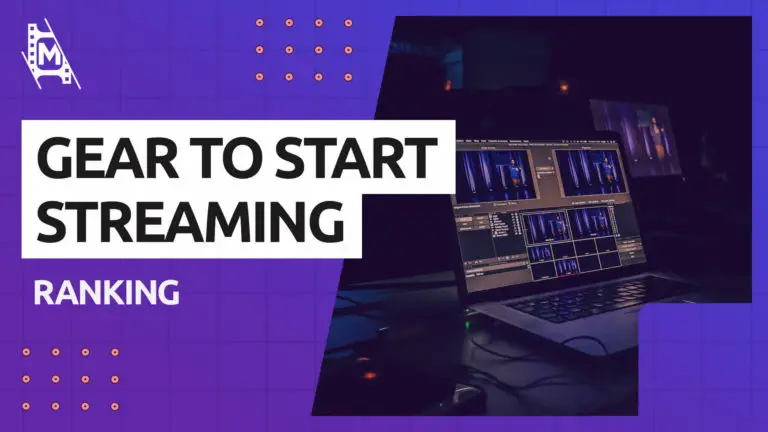Live streaming can be pretty overwhelming if you are just starting. This list will cover all the gear you need to get started and what you need to upgrade.
There is a lot of gear you can get, but that doesn’t mean you need it all right from the start. And also, keep in mind, equipment should never be in the way of creating content. Always start with what you have and find smart solutions if you are on a lower budget.
Essential Production Kit
Below is a list of the core streaming equipment essentials and everything you need to get started.
Camera
Web camera:
If you are starting with a smaller budget, a web camera is the best choice. They connect directly to your computer with USB and are easy to set up. There are web cameras designed for live streamers like Logitech C920 Pro Stream. They give you decent enough quality. Just make sure you are in a well-lit room as lighting conditions affect video quality.
Professional Cameras
You can use any other camera with an HDMI output, but then you also have to get a capture card to feed live video to your computer as you would with a web camera. The upside of using a professional camera is, of course, better overall video quality.
Entry-level cameras can provide decent video quality, but lighting conditions have to be good. Cheaper consumer cameras also tend to be lightweight but not very durable.
Most professional streamers use DSLR’s or Camcorders. With these cameras, you get higher resolutions, better video quality, and a full range of manual controls. One thing to note is that many cameras that can record in 4K often cant stream in those high resolutions. This is really not that important since 1080p resolution is all you need most of the time.
Capture Card
If you want to stream using a DSLR or other camera, you will need an encoder to connect it like you would connect a web camera. An encoder usually has HDMI input and output.
Microphone
Starting out, you could, of course, use a microphone from your headset, but the quality will be limited.
For most streaming setups, the ideal option is a USB microphone from a brand like Blue Yeti. Most other professional analog microphones require expensive equipment like interfaces and external power to run. This problem is eliminated with USB mics as they have all of that already built into them. USB microphones are ideal for a stationary desk setup and will give you high quality.
Tabletop Tripod
Even better than a tripod is a tabletop tripod. They are smaller and work for the most common desk setups for streaming.
Microphone Arm Mount
An arm mount can easily be attached to a desk and enables you to move the microphone on a horizontal plane. It is commonly used for gaming streams and podcasts.
Streaming Software

You need a software where you combine the audio and video sources and can add a live chat or other widgets to the live streaming footage.
The most popular streaming software is the OBS studio. It is entirely free and open-source.
PC
You will, of course, need a computer to live stream. While most gaming PC’s are built around the GPU, a streaming computer’s most important component is the CPU, in other words, the processor. It is the CPU that transcodes the image to a video format that can be streamed. You are looking for a CPU with multiple cores and threads like the Intel Core i7 9700K.
You also want an overall powerful computer with at least 8gb of RAM and a good graphics card. You might also want to consider a laptop if you’re going to be more mobile; in that case, the same system requirements apply.
Good internet
Having good internet is essential to live-streaming. The main thing you need to consider is the upload speed: how many bits of data you can share per second. Upload speed is measured by bitrate.
There are different recommended bitrates for different resolutions and broadcasters, and you should check with the streaming platform you want to use. Generally, something around 3-6 Mbps is minimum, depending on resolutions and framerates. To stream 1080p 30fps video, you need at least 4 Mbps.
There are many internet speed tests you can use to measure your upload speed, like www.speedtest.net.
So you did a speed test and got 4Mbps. So you can go ahead, or?
Not yet, you also need to consider how consistent that number is. Internet bandwidth and upload speeds fluctuate. Ideally, you want a 30% buffer to that number to be sure you won’t experience any performance issues.
Intermediate Production Kit
Above were the essentials for a good streaming setup, but there is a lot of gear you can get to improve production quality and make better live streams.
Dual PC Setup
With a dual PC setup, you are recording on one PC while offloading the streaming to a second PC. This spreads the resource load and gets rid of performance issues. A dual PC setup is most useful for gaming live-streams when a game takes up a lot of resources on your primary PC. A setup like this will also require a Capture Card to record live video from the recording computer and feed it to your streaming PC.
Lighting
For most indoor streaming setups, soft clean light is the most ideal. The best way to achieve this is with a softbox light. A softbox diffuses light without eliminating any hard shadows. Another option would be a ring light. You can read more about our lighting for videos guide here.
Second Monitor
A second monitor can be handy if you want to see the live chat while recording on the primary monitor.
Switcher (Hardware)
A switcher is a piece of hardware that allows for multi-cam live streaming. Some even offer live audio mixing for different sound sources. If you have a larger production, hardware switches are ideal.
